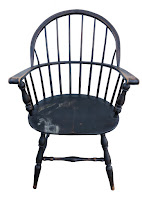 |
| Teacher's Desk Before |
Remember elementary school? Do you still remember your teacher’s desk? Well, this was once a teacher’s desk that used way back in the day of notebooks (not laptop computers), pencils, typewriters and maybe even an apple on the teacher’s desk.
Unlike the desks I remember from my early school years, this one had a unique feature; a slide-out, built-in filing cabinet with many cubby holes and slots for letters and other teacher-ish items. I had never seen a desk like this one. And you can imagine how extremely heavy it was!
 |
| Teacher's Desk After |
The desk top had been destroyed by fire. Our customer thought the top had water damage, but upon closer inspection, it was fire, not water that had destroyed the top. We also noted that the original desk was likely a roll top, which was no longer part of the desk. Unfortunately the top’s damage was so severe, it was not able to be restored. It had to be replaced.
We generally prefer to use the original pieces of our furniture restoration process, but when that isn’t an option, we rebuild it to resemble as closely to the original design as possible. The burnt top was comprised of border sections surrounding the center sections instead of larger boards simply glued together to create a uniform, single directional top. This was more involved and complex than a directional top and required much more wood in various lengths, but the new top was outstanding when it was done. Jim did a tremendous job in rebuilding the top to best represent the original one. If I was the teacher, I’d give him an A+!
Tedious would be an understatement in describing the process of refinishing and restoring this desk. Every drawer had to be removed and labeled. The pull-out filing cabinet was its own entity that required even more disassembly and extra steps. The unique part of this little cabinet was that it rotated so that the teacher could easily access the files in the back. It also had its original snap-in alphabetical folders that the teacher probably used to keep track of her students. The handles did not come off, so the stripping and sanding process involved keeping them in place and working around them. The inside of the desk, as well as the back, also had to be stripped, sanded and refinished. The stain used was golden oak with satin polyurethane to protect the desk for years to come.
 |
| Burnt Top |
 |
| Newly Built Top |









